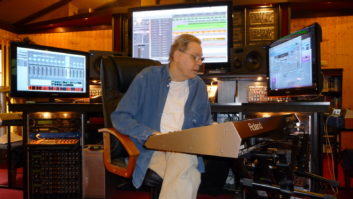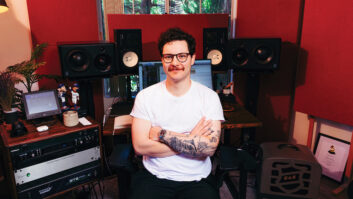Jake Smith, who records and performs under the moniker The White Buffalo, just released his new album, Shadows, Greys and Evil Ways—which immediately debuted at No. 1 on the iTunes Singer/Songwriter chart. What separates Smith from his contemporaries is his ability to put engaging songs—which he looks at more as “short films”—into a thematic, contextual context.
His new album, delivered in his gravelly voice that harkens to other great storytellers like Kris Kristofferson, focuses on a fictitious character, Joey White, a young man who goes to war and returns only to find more violence and struggles in his hometown. The album, recorded at his label’s (Unison Music Group) own studios near Los Angeles, features wide-open space and plenty of dynamics for Smith to tell his story. Pro Sound News spent time with The White Buffalo to take a closer look.
ON WRITING A CONCEPT ALBUM:
I had a bunch of these songs in the well, we went into pre-production and I laid them all down. It didn’t even occur to me that this was going to be a concept album, and I didn’t tell the producers or engineers that this was my goal. I’d always wanted to do one, though—and I took a look at these songs and said to myself, ‘I could arrange these to make a narrative, to make a longer story.’ Essentially I’ve always written songs as stories, so this was just making a longer story. So I took the compositions that I had—which were just the bones of things—and spent more time arranging them. I filled in the gaps and changed a bunch of the lyrics to make them as seamless as possible.
Other than the guys in the band, I don’t think other people involved in the process were really aware that I was making a narrative. It was definitely different from writing a regular album, and some of it was quite calculated— it had to be. The beginnings of songs were almost always stream of consciousness, but after that, everything else really needed to fall into place. The story is very focused and there’s not a whole lot of confusion.
ON DYNAMICS AND EMOTION:
In the studio, it is always harder for me to capture dynamics like I can during a live show. It seems like when I am playing live, it is so easy to get really huge, and then just suck it up into zero. On the album, though, it was kind of cool how I was able to change my vocal stylings for the main character. At the beginning, the vocal sounds very tender, then there’s more bravado later, and then he becomes aggressive and disturbed during the darker parts of the album. At the end, his voice almost takes on this crooning quality where he is a little wiser yet still unsure of where his place is in the world or the afterlife.
ON KEEPING IT ALIVE:
This is my second album with the same engineers and producers—we all seem to get each other. We tried to make the record sound as live as possible. It is me, Tommy Andrews on bass guitar and Matt Lynott on drums. For that first four or five days in the studio, we were busy getting drum tones and the drum tracks down. Then we pieced the rest together— I came in and overdubbed the guitars and the bass. Once all these elements were in place, then we start getting other musicians in. Bruce [Witkin], one of the co-producers, plays a lot of stuff; he did a lot of the baritone guitar work and a little bit of keys and bass. He’s a super-talented musician.
ON GUITARS AND STRINGBREAKIN’:
On this album, I used a dreadnaught Taylor that is owned by the studio. Some guitars lean towards a low-end or high-end sound, but this one just records very crisp and clean, and covers the whole spectrum. I am a real stringbreaker and I probably break strings more than anybody. I’ve been recording and performing with the biggest strings you can get and I still break them. To record the guitar, we had a DI and two mics—one of them was a Neumann small condenser just off the neck and the other was a large diaphragm placed in front of the guitar.
ON INSTRUMENT OVERDUBS:
All the strings and piano work happened later in the process. The musicians come in, and we’ll trust them and produce them as they are going along. Other times, these overdubs might be melody lines that Bruce, Ryan [Dorn, engineer] or myself will come up with. As we record and the skeleton starts to take shape, it’s a process of whether something sticks or if it’s too much. We did a lot of violin and baritone guitar, and that worked well. The baritone guitar is almost like a lead instrument, and represented some of the masculine parts of the narrative. The female part [Jolene character] is more or less represented by the tender violin parts. We didn’t really make these conceptual associations until a little bit later, when Bruce and I were going over the parts.
ON REFLECTION:
I don’t think anyone has tackled a narrative like the one I’ve done in quite a while. It’s very real, very honest and a very human story. It’s not this ethereal concept album.







